Chernobyl, My Primeval, Teeming, Irradiated Eden
Decades after the Soviet-era meltdown drove 60,000 people from their homes in the Ukraine, a rebirth is taking place inside the exclusion zone. With Geiger counter in hand, the author explores Europe's strangest wildlife refuge, an enchanted post-apocalyptic forest from which entirely new species may soon emerge.
New perk: Easily find new routes and hidden gems, upcoming running events, and more near you. Your weekly Local Running Newsletter has everything you need to lace up! Subscribe today.
The wild boar is standing 30 or 40 yards away, at the bottom of a grassy bank, staring right at me. Even from this distance I can see its outrageously long snout, its giant pointed ears, and the spiny bristles along its back. It looks part porcupine, a number of shades of ocher and gray. And it's far bigger than I expected, maybe chest-high to a man. The boar is like some minor forest god straight from the wilderness, gazing wild-eyed at the strange spectacle of a human being. For a moment it seems to consider charging me, then thinks better of it. When it trots away, it moves powerfully, smoothly, on spindly, graceful legs twice as long as a pig's, and vanishes into the trees.
Chernobyl Exclusion Zone
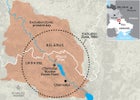 Chernobyl Exclusion Zone
Chernobyl Exclusion ZonePripyat Amusement Park
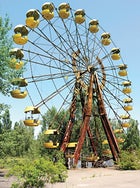 Pripyat Amusement Park, which was set to open when the accident occurred
Pripyat Amusement Park, which was set to open when the accident occurredChernobyl Farm Couple
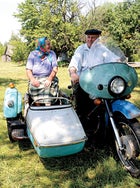 A farm couple at home, five miles from the reactor
A farm couple at home, five miles from the reactorChernobyl Biotechnician
 A biotechnician and his lab partner
A biotechnician and his lab partner
I climb back into our VW van, tingling all over. The sighting bodes well. I've come to what is being dubbed Europe's largest wildlife refuge in early July, when I knew spotting animals wouldn't be so easy. (Winter, with its scarcity of food and lack of foliage, makes them more visible.) And within a couple of hours I've ticked a wild boar off the list. Maybe luck is on our side.
But luck isn't our only obstacle to wildlife spotting here. This is northern Ukraine's Chernobyl Exclusion Zone, a huge area, some 60 miles across in places, that's been off-limits to human habitation since 1986. Even now, 19 years after the collapse of the USSR, nothing happens in this former Soviet republic without sheets of paper typed and stamped in quintuplicate. It took months of e-mails and phone calls to get permission to spend a few days here. Yes, we're only a couple of foreign vagabonds—photographer Rory Carnegie is an old travel buddy of mine from England—but we have cameras and a telephoto lens, and my notepad has lines in it: obviously we're spies. The Soviet Union may have died, but the Soviet mind-set has not.
At the Chernobyl Center, a kind of makeshift reception building in the heart of the old town, I had to hand over a solid nine inches of local bills—hryvnia, pronounced approximately like the sound of a cardsharp riffling a deck—sign a stack of agreements, compliances, and receipts, and then get checked on an Austin Powers–style Geiger counter made out of chrome. Finally, under the protection of a guide, a driver, and an interpreter, we were free to set off into the zone—as long as we did exactly what our guide said.
A handful of dilapidated roads cross the zone, half-overgrown with weeds and grasses, and the whole area is littered with pockets of intense radiation, but nature doesn't seem to mind. All nature seems to care about is that the people, along with their domestic animals, are for the most part gone. The zone is reverting to one big, untamed forest, and it all sounds like a fantastic success story for nature: remove the humans and the wilderness bounces right back. Lured by tales of mammals unknown in Europe since the Dark Ages, we're setting out on an atomic safari.
The zone is reverting to one big, untamed forest, and it all sounds like a fantastic success story for nature: remove the humans and the wilderness bounces right back.
It was soon after 1 a.m. on the night of April 26, 1986, that one of the world's nightmare scenarios unfolded. Reactor 4 in the huge Chernobyl power station blew up. The causes are still the subject of debate, but it was some combination of a design flaw involving the control rods that regulate reactor power levels, a poorly trained engineering crew, a test that required a power-down of the reactor, and a dogged old-style Soviet boss who refused to believe anything major could be wrong. At any rate, it was spectacular. Eight-hundred-pound cubes of lead were tossed around like popcorn. The 1,000-ton sealing cap was blown clear off the reactor. A stream of raspberry-colored light shone up into the night sky—ionized air, so beautiful that inhabitants of the nearby city of Pripyat came out to stare. When it was all over, estimates former deputy chief engineer Grigori Medvedev, the radioactive release was ten times that of Hiroshima.
Chernobyl had been a mostly peaceful settlement for 1,000 years and a predominantly Jewish town for the past three centuries, famous for its dynasty of Hasidic sages. Since the Russian Revolution, the Jews have thinned a lot, but even today there are two shrines to the Hasidim where once a year devotees come to light candles and pray. It's incredible what survives a disaster. As Emily Dickinson said, “How much can come and much can go, and yet abide the world.”
In 1970, nine miles from the town, the Soviet Union started building what they hoped would become Europe's largest nuclear power station. (Only four of the planned eight reactors had been completed when disaster struck.) To go with it, they erected a brand-new concrete city, Pripyat, whose 50,000 inhabitants greatly outnumbered the 12,000 living in Chernobyl. The nuclear industry fell under the military complex, and the traditional Soviet culture of secrecy was all over it. Radiation is bad enough, but compound it with Soviet pride and paranoia and you have a potent mix of Kafka and Ray Bradbury.
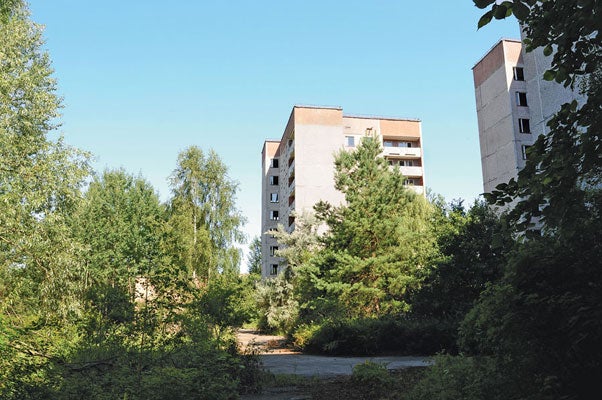
The first the rest of the world knew of the Chernobyl disaster was when workers at a Swedish power station more than 1,000 miles away reported for work two days later, checked themselves with a Geiger counter, and found they were highly radioactive. By the following day, April 29, radioactive clouds had been carried by prevailing winds right across Western Europe and into Scandinavia, and The New York Times ran a front-page story about the catastrophe. The Soviet newspaper Pravda devoted a full eight lines to the “accident” that day—on its third page. It wasn't till May 15, three weeks later, that General Secretary Mikhail Gorbachev finally announced what had happened.
Thirty people died on the night of the explosion or soon after. Two days later, a convoy of 1,100 buses shipped out all the inhabitants of Pripyat, turning it into a ghost city overnight. The vast might of the Soviet Union went into overdrive with a massive cleanup operation involving 600,000 workers. A layer of topsoil was removed for miles around the site. (The government has not said where it went, but many believe it was dumped in the nearby Dnieper River, where silt would have buried it.) Hundreds of thousands of trees were planted, to bind the ground and reduce the spread of radioactive dust.
But the cleanup turned out to be even more lethal than the explosion itself. Soldiers were offered two years off their service in exchange for just two minutes shoveling nuclear waste. Thousands of people won medals for bravery and were declared Heroes of the Soviet Union but at the same time picked up cancer and thyroid problems that would dog them for the rest of their lives. Thousands of evacuated locals and cleanup workers are said to have died in the ensuing years from radiation doses, and it's reckoned that some 2.7 million people alive today in Ukraine, Belarus, and Russia have been directly affected by it.
In the following weeks, bureaucrats in Moscow designated an 1,100-square-mile Exclusion Zone—roughly the size of Yosemite—reasoning that the farther from Chernobyl people were, the better. This is mostly true: almost all of the crew working at the reactor when it blew died within a few weeks, as did several of the firemen who arrived on the scene minutes later, but the backup laborers who got there later mostly survived, albeit with dire health problems.
In all, two towns and an estimated 91 villages were emptied. But radiation doesn't travel consistently or evenly. If radioactive dust is picked up by a cloud, it will fall where the rain falls. There are still parts of Wales where the sheep farmers can't sell their meat, and last summer thousands of wild boars hunted in Germany were declared dangerously radioactive.
On the outside, the fauna seems to be thriving. The question scientists are trying to answer is what's happening on the inside: in their bones, and in their very DNA.
Today, around 5,000 people work in the Exclusion Zone, which over the years has grown to an area of 1,660 square miles. For one thing, you can't just switch off a nuclear power plant. Even decommissioned, it requires maintenance, as does the new nuclear-waste storage facility on site. The workers come in for two-week shifts and receive three times normal pay. Any sign of disease at the annual medical, however, and they lose their jobs.
There are also some 300 people living in the zone: villagers who've been coming home to their old farming lands since not long after the disaster and teams of radioecologists from around the world who've come to study the effects of radioactive fallout on plants and animals. They've effectively turned the zone into a giant radiation lab, a place where the animals are mostly undisturbed, living amid a preindustrial number of humans and a postapocalyptic amount of radioactive strontium and cesium. On the outside the fauna seems to be thriving: there have been huge resurgences in the numbers of large mammals, including gray wolves, brown bears, elk, roe deer, and wild boar present in quantities not recorded for more than a century. The question scientists are trying to answer is what's happening on the inside: in their bones, and in their very DNA.
Once you enter the zone, the quiet is a shock. It would be eerie were it not so lovely. The abandoned backstreets of Chernobyl are so overgrown, you can hardly see it's a town. They've turned into dark-green tunnels buzzing with bees, filled with an orchestral score of birdsong, the lanes so narrow that the van pushes aside weeds on both sides as it creeps down them, passing house after house enshrined in forest. Red admirals, peacock butterflies, and some velvety brown lepidoptera are fluttering all over the vegetation. It looks like something out of an old Russian fairy tale.
Ukraine officially opened Chernobyl up to tourism in January 2011, but small groups have been able to visit the zone for the past few years. There are small tour operators based in Kiev that take visitors on day trips. You don't need Geiger counters or special suits; you just have to stay with the tour, pass through several checkpoints, and get tested for radiation on your way out. The tours will shuttle you around some of the main sites—the deserted city of Pripyat, a small park filled with old Soviet army vehicles used in the cleanup, various concrete memorials to the fire crews who lost their lives after the blast. Visitors are strictly confined to areas the authorities have scanned and declared safe.
Staying longer than a day is more complicated. The Chernobyl Center has a guesthouse where nonofficial visitors like us can stay and be fed delicious if overpriced Ukrainian stews and escalopes. At sundown each evening there's a curfew. Walk to the nearby shop where the local workers buy their beer and bread and you could get yourself arrested.
Chaperoning Rory and me at the center and on our daily excursions is our guide, Sergey. He lives in a town near Kiev, but for the past ten years he's been spending two weeks out of every four in the zone, showing visiting scientists and the odd tourist around. Sergey is a tough, taciturn guy who looks like an old sergeant major, with a silver mustache and a head of cropped white hair. Our plan is to explore the forest, the old town of Chernobyl, the nearby rivers, the empty city of Pripyat, and some villages where a few peasants are still living. One of the papers we had to sign when we entered was an agreement that if we stepped anywhere Sergey hadn't told us to, we wouldn't hold the authorities responsible for any health issues.
So far, the only visible sign of radiation has been a digital readout on the mostly deserted post-office building in Chernobyl. Instead of telling the time and temperature, it shows the micro-roentgen levels in different sectors of the zone, which fluctuate according to changes in background radiation and the weather.

The most contaminated of the villages were bulldozed and buried soon after the explosion, with only a few mounds and ridges left to show they were ever there. The meadows are mostly gone, replaced by forest. Russia is a land of forests, but the true forest, the primeval untouched forest that human eyes may never even have seen, is called pushcha—which roughly translates as “dense forest.” This is what has been reestablishing itself at Chernobyl, regenerating at an unprecedented rate.
At the edge of Chernobyl, we stop by the half-mile-wide Pripyat River. It's unbelievably peaceful. A black dog, which knows Sergey, slumps down in the grass beside us. A handful of long, stoved-in rowboats moored at the shore take me back to the punts of my Oxford childhood. They're stamped with the initials of the local KGB and must have been moldering here since Soviet times. Frogs plop into the water, boatmen skedaddle across the surface, dragonflies hover—it's like a weight has been lifted from the world. A sparrowhawk turns in lazy circles; a pair of ducks race by, low down, necks stretched, and make it to a willow on the far bank with a clatter of relief.
We pass two brick sheds with padlocks on their doors: the shrines of zaddiks, Jewish wise men.
“Why locked?” I ask Sergey.
Not missing a beat, he says, “Many people don't like Jews.” (Something else that survived the apocalypse.)
We meander along the sleepy brown river. The main sounds are the different shades of hissing of wind in the trees: high nearby, deeper and steadier farther away. Occasionally the wind picks up, flicks a ripple along the surface. This must be what life was like 1,000 years ago, when the entire human population of the globe was roughly 250 million. There's space for everyone, time for everything.
On our way down off the bridge, we spot a slender roe deer 200 yards up the road. It stands still a moment, head cocked, then like a sylph it slips into the trees, so swiftly I don't even see it go. A little farther on, we spot an elk between two bushes. He looks at us, head lifted, then strolls out of sight.
The van drops us off at a dark footpath that winds up through the woods, past a chain of collapsed wooden houses. Inside, their floors are littered with clothes, bottles, stuffing from mattresses. Pieces of gutted insulation lie strewn like corpses under the trees. It's not so much a town with trees in it as a forest with an old town falling to pieces within it.
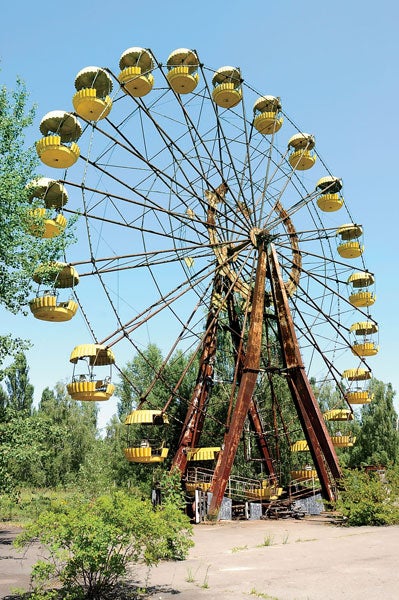
Sergey tells us about the herds of boar he has seen, 50 strong, rampaging through the forest. And about a starving wolf pack that surrounded a scientist friend of his in a wood one winter day. He had to shoot every last one to get away.
It's not just the forest that's come back but all its creatures. It's the land of Baba Yaga, the old witch of Russian folktales. Is this the world before humanity? Or after? Is there a difference?
Traveling in Ukraine can be quite a party. The Ukrainians prefer not to engage in talk on its own. It's better with a bucket of vodka and a carton of cigarettes.
It's three in the afternoon of our second day when seven of us settle at a makeshift table beneath a spreading mulberry tree in the luscious garden of Ivan Nikolayevich's home. Officially, no one is supposed to live here, but within a few months of the disaster, several hundred farmers, families like this one, returned to their ancestral homes and have been quietly living here ever since, tolerated by the government and apparently free of any unusual health problems.
We're in the tiny village of Upachich, deep in the zone. There's Ivan himself, dressed in a sleeveless shirt with only one button and a pair of trousers that have seen so much yardwork, he could be a man from any of the past few centuries. When we met him half an hour ago, he had just finished gathering up his small field of hay with a pitchfork, building the kind of hayrick Monet and Van Gogh loved to paint. There's Ivan Ivanovich, his son, who was helping him, with designer stubble and a wristwatch that place him somewhere in the past few decades. The two of them are still dripping and red-faced from their labors. And there's young Ivan's mother, Dasha, wearing a timeless Russian babushka headscarf and a subtle, sublime smile.
It feels like we haven't walked into a home so much as a story by Gogol. Corncobs are drying on a line. Indoors, there's a big stove with a built-in shelf on top for sleeping on in winter, buckets of potatoes standing on the floor, scraps for the hens, a basin with its own cistern you fill up from the well.
Ivan the son is busy wiping down the table, spreading out sheets of newspaper for all the foodstuffs: eggs from chickens pecking under our feet, tomatoes from the garden, bread, a bowl of tiny forest raspberries, a whole dried river fish, crystallized and orange from its time smoking in a homemade stove. It's all local and it all looks great, but most tempting of all are the mulberries hanging above my head. They resemble elongated blackberries, and there's something about the way they're growing among the elegant oval leaves of the tree that makes them irresistible. I'm dying to reach up and grab one, but they frighten me. We're only ten miles from the power station.
Whatever you do, friends advised before we came, don't eat anything that grows there.
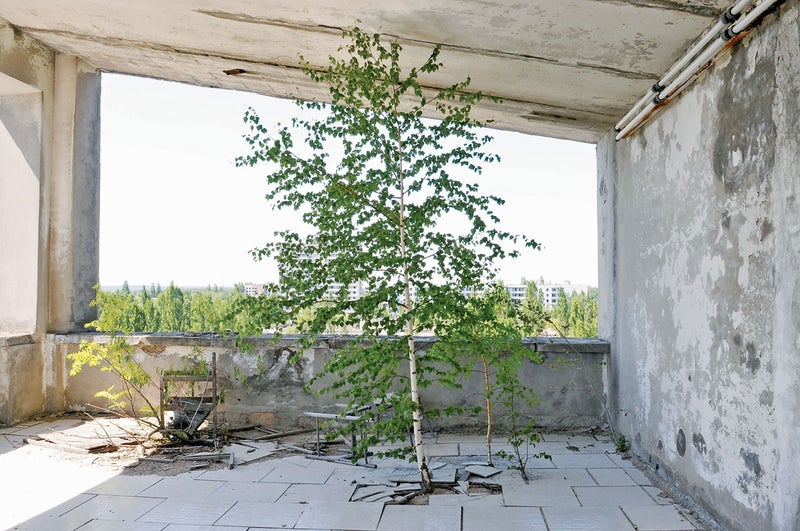
The older Ivan comes out of the house carrying a glass jar full of clear fluid in his trembling hand.
“Vodka,” someone declares appreciatively.
That'll be safe, I think to myself: shop-bought.
“No, no. Samogon,” Sergey explains, eyeing the jar with a gleeful twinkle. “Better than vodka.”
Samogon?
“Homemade.”
My heart sinks. The local moonshine. But before I can ask if it's really safe to drink, we're clinking glasses, wetting our fingers, and I cautiously take a sip.
“You're not exactly drinking as you should,” Sergey notes, suggesting that I chug.
“Clean—it must be clean!” declares one of the Ivans.
Sergey is already slamming down his empty glass. What can I do but oblige?
Conversation begins to flow. Sergey starts expatiating on the advantages of village life. “When you want make business, make networking, you live in the city. But here, there is natural food, for example this samogon, it is so good for you.”
Radiation is scary because it's mostly undetectable to the senses. Still, it's a fact of life—we all live under constant radioactive bombardment, and the less complex the organism, the more likely it can handle high doses.
I'm far from sure, but the dad gets up and shows me round the garden. He wants me to see where the tomatoes grow, and the grapes and vegetables, and where he finds the root he uses in his special medicinal vodka. Swaying, puffing, he pulls up a little plant, then lumbers off to the pond to rinse it: a lump of ginseng.
A couple of samogon shots later, my fears have abated and I'm tucking in like the rest. The fish is so smoky my eyes water, and soon my hands are stained bloodred from all the mulberries I've eaten. A bird starts singing. Flakes of sunshine shift over us. The hay is in, there's a pig fattening for Easter, and the oats are almost ready for the scythe. If this isn't rustic life at its timeless, bibulous best, what is?
Most everyone in Chernobyl displays a predictable bravado about living with radiation. In the relative cool of the evening, the workers on their two-week shifts gather outside the guesthouse to sit on tree stumps and chew the fat, drink beer, smoke cigarettes. With a line of dark chestnut trees nearby and the pale night sky overhead, amid the silence and stillness of the deep forest, it's a lovely scene, even with the insistent black mosquitoes that bob around our faces.
“Radiation is good for you,” one of them tells me. “Every year I get younger,” says another. And another: “I work here so when I come home glowing my wife will think I'm a god.”
A particularly hearty-looking man who works as a janitor asks me, “How old do you think I am?”
“Sixty,” he answers himself. A preposterous answer: he looks not a day past 30.
The best decontamination? “A bottle of vodka.”
But radiation is scary. It's particularly scary because it's mostly undetectable to the senses. If you feel sleepy and have a chemical taste in your mouth, it might be because of radiation. If you're able to see it, in the form of purple ionized air—as they did that night in April—or, worse, feel it in the form of instant-tanning heat, it's probably too late for you.
Still, it's a fact of life. We all live under constant radioactive bombardment: there's solar radiation, terrestrial radiation, there's even radiation in our food, since all living things contain radioactive potassium-40 and our food consists mostly of once-living things. There are different units of measurement—like dps, or disintegration per second, and curies, grays, sieverts, rads, rems, roentgens, and so on. The average terrestrial dose is three microrems per hour—but in some parts of the world this goes as high as 100 microrems, with no perceptible ill effects. (In fact, there's some evidence that cancer rates are lower in these areas; perhaps mild stress to the immune system makes it work better.)
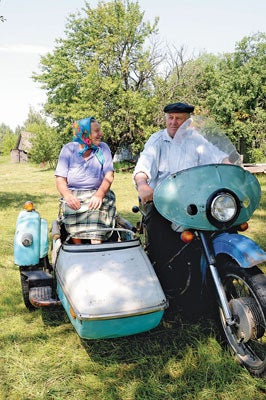
A dangerous dose is hard to pin down. Worldwide, for most people, those daily microrems add up to about 360 millirems per year. Scientists agree that humans can safely handle 1,000 a year. Astronauts on the International Space Station receive 18,000 millirems of cosmic radiation over six months—but it's once in a lifetime, so it's seen as an acceptable, voluntary risk. But edge that up to 30,000 millirems and you're looking at what caused increased cancer rates among the blast survivors of Hiroshima and Nagasaki. And yet animals can handle even more than this: large mammals and birds are generally safe with 36,000 per year, small ones with even higher doses, and reptiles with higher still. The more complex the animal, the more sensitive it is.
Nuclear power involves various radioactive substances that differ from the hydrogen isotopes in a modern thermonuclear weapon. There are the fissile materials (which make the reaction happen) like plutonium and uranium, and the fission products (which result from it) like radioactive iodine, cesium-137, and strontium-90. It's these last two, along with some plutonium, that mostly contaminate Chernobyl today. Some emit alpha or beta particles, some gamma rays. Alpha particles have a short range: in air, one to two inches; in skin, one to two thousandths of an inch. So if they're coming from outside you, they can't penetrate your skin. But if inside—if you've eaten something contaminated, for example—they're nasty. Their short range means they're more likely to deposit their energy within a small area—small enough to attack both strands of a DNA molecule, possibly causing cancer. Beta particles, meanwhile, can travel about 20 feet through air and a quarter of an inch through skin; they can't reach internal organs from outside the body. Gamma rays are essentially X rays. They can be more or less penetrating, depending on strength.
The half-lives of radioactive materials vary, too. Cesium's and strontium's are around 30 years, plutonium's is 88 years, but with uranium-238—the base product used to create plutonium—it's more than four billion years. A long half-life means the substance remains radioactive much longer but gives off its radiation more slowly. The half-life of radioactive iodine is only one week, which means it gives off a lot of radiation quickly—another reason the Soviet authorities were so irresponsible in not announcing the Chernobyl disaster sooner: a lot of lethal, iodine-contaminated food got eaten those first few days after the explosion.
All through our trip, Sergey has been telling us how healthy he is. Only at the end will he reveal that he can't run anymore because of pains in his legs—but it's fine, he says, because the pain is only in his muscles, not his bones.
All through our trip, Sergey has been telling us how healthy he is, in spite of ten years in the zone. Only at the end will he reveal that he can't run anymore because of pains in his legs. Too much “strontsy,” he says. But he's fine, he adds, because the strontsy is only in his muscles, not the bones. Not yet anyway.
One of the workers tells me he doesn't drink, not even beer. “I do sports, so I cannot drink,” he says, lighting up another cigarette.
“But what about the radiation?” I ask him.
He shrugs. “Life itself is dangerous, my friend.”
The world beyond the apocalypse may not be so great for humans, but for the other denizens of the planet it looks like a bonanza. Today there are around 5,000 adult wild boars in the Chernobyl Zone. In 1995 there were many more, but they suffered an epidemic and have now stabilized. There are 25 to 30 wolf packs, a total of maybe 180 adults. Many more lynx live here than before, along with foxes, barsuks (a Ukrainian badger), hundreds of red deer, and thousands of roe deer and elk. Out of the disaster comes a paradise of wildlife. The Garden of Eden is regenerating.
But it's not so straightforward.
For 17 years, biologist Igor Chizhevsky has been studying how animals metabolize cesium and strontium. He works with the Chernobyl Radio-Ecological Center and is a friendly, serious, broad-faced man. He has made Chernobyl his career. When he comes to talk with us in the guesthouse, he sits stolidly in an armchair, barely moving at all for an hour, while telling us in a doleful Slavic voice about how things are really going down here for the animals.

When humans abandoned the zone, he says, it wasn't just they and their domestic animals—including 135,000 cattle—that left. The “synanthropic” species that live around humans—pigeons, swallows, rats, and the like—also left the territory in large numbers, leaving it free for a wild ecosystem to reestablish itself.
“Structure of entire fauna system change,” Igor says.
House mice, which thrived on grains no longer grown here, have been replaced by forest and field mice. Likewise with the bird species. But it's the larger mammals we're interested in.
On the surface, Igor says, the wildlife seems to be thriving, but under the fur and hide, the DNA of most species has become unstable. They've eaten a lot of food contaminated with cesium and strontium. Even though the animals look fine, there are differences at the chromosomal level in every generation, as yet mostly invisible. But some have started to show: there are bird populations with freakishly high levels of albinism, with 20 percent higher levels of asymmetry in their feathers, and higher cancer rates. There are strains of mice with resistance to radioactivity—meaning they've developed heritable systems to repair damaged cells. Covered in radioactive particles after the disaster, one large pine forest turned from green to red: seedlings from this Red Forest placed in their own plantation have grown up with various genetic abnormalities. They have unusually long needles, and some grow not as trees but as bushes. The same has happened with some birch trees, which have grown in the shape of large, bushy feathers, without a recognizable trunk at all.
“Genomes, er, unpredictable,” says Igor. “Genome not exactly same from generation to generation. They change.”
This is not good for a species. Genomes are supposed to stay the same. That's what holds a species together. No one knows what these changes could result in.
“Soon or late,” Igor says, “new species will evolve.”
In other words, new animals could actually be in the making here. The area has become a laboratory of microevolution—”very rapid evolution,” says Igor—but no one knows what will emerge or when.
One Stanford scientist I spoke to later had a terse summary: if there are genetic changes, and if these pass down to the next generation, and if they survive natural selection, then it's reasonable to talk of evolution. There are two theories about why this may happen. In classic Darwinism, random genetic changes that help an organism survive in its environment are naturally selected through generations, because the individuals with those characteristics do better. But “mutagenesis,” an alternate theory, posits that organisms deliberately adapt to their surroundings. The process is not accidental. For example, in Chernobyl, if mice are developing radiation resistance by passing down cell-repair systems, is that because some individuals just happened to develop this attribute and to fare better, or is it because the species deliberately developed this capacity in response to the environment?
While changes at species' chromosomal levels are as yet mostly invisible, a survey of radioactive mice, albino birds, and color-shifting pine forests contradicts the image of health.
Sergey takes us to a real-life laboratory nearby: just an old house, but inside it's been gutted, and the walls are lined with shelves of cages, each one full of scurrying white mice. A rank stench hits us as soon as we walk in.
The white-coated lab technician—yet another Ivan—notices my grimace and smiles. “Yes,” he says. “And we just cleaned the place this morning.”
He explains that they're studying the effect on the mice of the radioactive spectrum here in the Chernobyl Zone. They took probes from the Red Forest and re-created the conditions here at the lab, then started giving the mice food laced with cesium and strontium.
Why here? I ask.
“This is already a contaminated area. So we don't risk spreading radiation elsewhere.” In other words, the zone has become a kind of refuge for radiation research.
He and his team are studying the mice to understand their resistance to radioactivity. They've found sensitivity to ionization, which results in certain tumors, and some of this passes down through the genes. But they're also finding heritable radiation resistance—which could perhaps be beneficial to humans someday.
In spite of being a clearheaded scientist, Ivan gives us a surprise when asked if he's OK being photographed. He starts laughing nervously. “I'm afraid of American shamans and what they may do to me,” he confesses. Apparently, some old-time beliefs are still being inherited around here too, even in a science lab. The Ukrainians are complex people: part Soviet, part soulful Slav, part subsistence farmer. Even this lab has its own vegetable patch out front.
On our last morning I wake up early, and as I lie in my bed at the dorm I hear, quite distinctly, a wolf howling. It holds its note a long time before reaching for a higher one, then a still higher one. It sounds like a healthy howl. But no biologist has yet been able to study these wolves in sufficient numbers to have a clear idea of their genetic health. They know what their bellies are full of, but the meat has its own genetic instability. These wolves may have a vast untracked forest to roam, but what is happening deep in their DNA no one knows. Will there be new species in a few generations? There may already be, out in the forest, and we wouldn't even know.
Later that morning, on our way to the ghost city of Pripyat, we see a fox darting across the road—nothing more than a black silhouette, curiously low to the ground. Or perhaps it was a small wolf, says Sergey. Then a big bird, which turns out to be an eagle, is suddenly ahead of us, grappling with a sapling it has attempted to land on, bending it down low, then letting the young tree spring back up again as it rides away on giant brown wings.
Sergey tells us that Pripyat used to be the most beautiful, spacious city he ever saw. More roses grew there than anywhere else he ever knew. There were never any shortages, and you could get fine clothes, Czech-made shoes. It was a model of what Communism was supposed to have been.
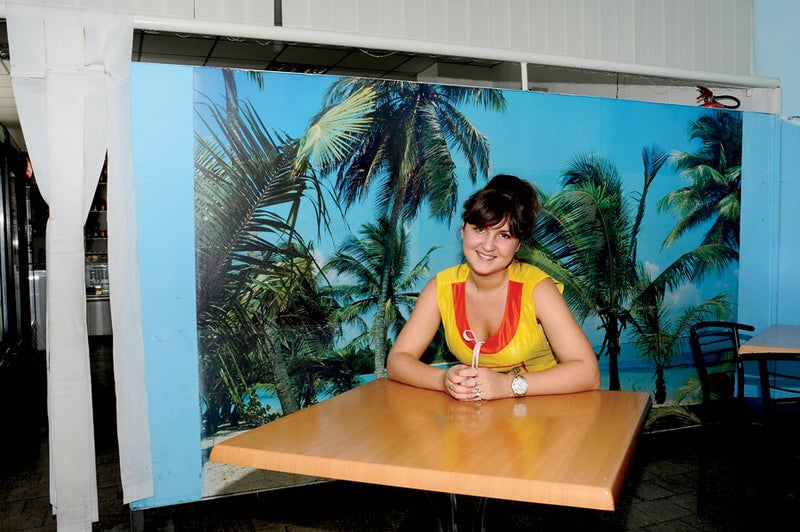
It's weirdly distressing to be here. As a human, it's like staring down the barrel of our likely fate. We may wipe ourselves out with a nuclear holocaust, or with carbon and methane, or some other way we can't yet conceive of. Or nature may do it for us. When it happens, trees may or may not mind. Cyanobacteria poisoned their own atmosphere two and a half billion years ago by releasing vast quantities of a gas that was poisonous to them—oxygen—and in the process created an atmosphere suited to higher forms of land life. Who knows what creatures may adapt to a high-carbon, high-methane atmosphere if we keep going the way we are? They may include us, or not.
From Pripyat we drive on to the old power station itself. It's a large area of vast concrete buildings. One of them is the stricken Reactor 4, some 200 feet tall, with a giant chimney still rising out of it. For almost 25 years it's stood encased in a “sarcophagus” of cement, but the seal is far from perfect, and it leaks dangerously. We park 200 yards away to look at it but stay only a few minutes. A new steel sarcophagus is slowly being built; when finished, it will be the world's largest movable structure.
There are canals threading through the giant buildings, which provided water for the old coolant system, and in one of them the catfish have grown to prodigious sizes. We stop on a metal bridge and gaze down into the brown water. Suddenly the monsters rise to the surface, some of them a good ten feet long, black, whiskered, curling around as they hunt for the bread people feed them.
They're not big because of radiation, Sergey insists. It's just that they haven't been fished for a quarter of a century.
It's weirdly distressing to be here. As a human, it's like staring down the barrel of our likely fate. We may wipe ourselves out with a nuclear holocaust, or with carbon and methane, or some other way we can't yet conceive of. Or nature may do it for us.
The whole area is like this: fecund, scary. Later Sergey takes us to an army barracks where some soldier friends of his keep a few wild pets. From the dark doorway of one of the sheds issues a terrific subterranean grunt, and a moment later, as if in a hurry, out trots another wild boar. It comes straight at the fence, presses against it with the weird, wet sucker of its long, long nose, then raises its bristly head and eyeballs me as if I'm something from another planet.
In a pen next door there's another forest sprite—the barsuk, a very close relative of our badger. When it comes out of its kennel, it runs up a woodpile, turns at the top, and proceeds to stare right into me with deeply strange eyes. Something in me seems to recognize something in it, and I feel a pang of longing. Is it for the deep forest, the pushcha? For the trees, the smell of autumn leaves, of mushrooms and mold? For the freedom to live our own way, far from society?
Crouching and staring, the barsuk doesn't move a muscle. It could be a stuffed animal, with eyes of glass. Or perhaps a new species, staring at the world with new eyes.


